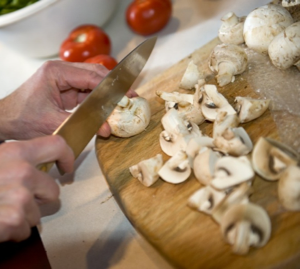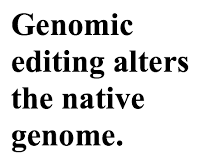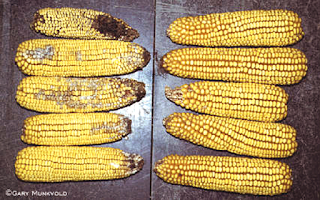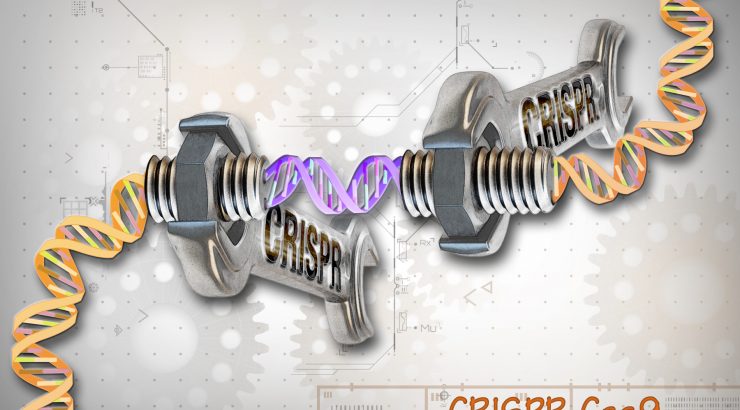CRISPR-Cas9: the biological Photoshop® and GMO food regulation loophole By Tara A. Okuma, MS in Food Science student
November 7, 2016
Avid Photoshop® users know how to nip, tuck, add, remove, and edit whatever they desire in photos. Edited and enhanced photos can be commonly seen throughout fashion magazines, but editing photos doesn’t change who the person is. Does it? The perceived body may be changed and skin blemishes may miraculously disappear thanks to Photoshop® but it’s still the same person in the photo. Photo editing enhances, enriches and improves photos for advertising and sales. Why not do the same with food—edit, enhance and improve agricultural crops while decreasing food waste and damage? Well, food biotechnologists already have! The CRISPR-Cas9 system, a genomic editing tool designed by biologists, is currently being used for crops and future food. CRISPR (pronounced as “crisper”) stands for Clustered Regularly Interspaced Short Palindromic Repeats and Cas9 is from CRISPR associated protein 9. This system is composed of two components, a homing device (guide RNA or gRNA) that locks onto the DNA target of interest like a missile honing in on its target. The second component is a pair of molecular scissors (Cas9), a guided enzyme that tags along with gRNA to edit the target DNA and do whatever gRNA tells it to. The CRISPR-Cas genome editing system is becoming widely popular among food geneticists and is also being described as a “biological find-and-replace”.
Editing crops

Photo credit: Katherine Frey/The Washington Post
CRISPR-Cas9 is the newest genomic editing tool that is more precise, accurate, faster and less expensive than older tools, and genome editing is currently dominating food research and development. Plant pathologist, Dr. Yinong Yang and his team at Pennsylvania State University developed an anti-browning white button mushroom (Agaricus bisporus) using the CRISPR-Cas9 technology. Sliced, bruised and/or damaged produce such as mushrooms, apples and potatoes undergo browning over time due to the release of an enzyme called polyphenol oxidase (PPO) from plant cells. Most enzymes are proteins that catalyze or accelerate biochemical reactions, and since PPO causes enzymatic browning, Yang and his team removed the gene producing PPO to prevent the unwanted discoloring. Therefore, mushrooms moving from the farm to your produce aisle would maintain their creamy off-white color and appearance of being fresh and undamaged.
DuPont also announced two types of CRISPR-Cas-edited corn: a drought-tolerant corn that survives drought-stressed conditions while increasing yield and a waxy corn hybrid that is expected to be available to farmers within the next five years, pending trials and regulations. The high amylopectin starch in waxy corn has many food and non-food applications, including thickening and texture in processed foods and non-food adhesive tapes and papers. Corn consists of two main starches: amylose and amylopectin. DuPont turned off the gene producing amylose using the CRISPR-Cas system so that their waxy corn hybrid mainly produces amylopectin starch, resulting in cost-effective and increased amylopectin production.
In addition, Monsanto recently announced their intent to use the CRISPR-Cas system by entering into a licensing agreement with the Broad Institute of MIT and Harvard University. The CRISPR-Cas genome editing system is planned to be used to help improve global agriculture and will be a great addition to Monsanto’s research and development team.
In addition, Monsanto recently announced their intent to use the CRISPR-Cas system by entering into a licensing agreement with the Broad Institute of MIT and Harvard University. The CRISPR-Cas genome editing system is planned to be used to help improve global agriculture and will be a great addition to Monsanto’s research and development team.
Genetic editing vs. GMO
 With genetically modified organisms (GMOs) prominent in the media and the GMO debate still smoldering, how does genetic editing differ? Genetic modification (GM) involves inserting foreign DNA segments from one species into the genome of another. For example, a gene producing pesticide-like protein originally from soil bacteria was copied and then inserted into the corn genome. Also known as “Bt corn,” this GM crop produces protein that is lethal to insects and pests that commonly attack corn crops and causes major crop damage and decay. Whereas genomic editing techniques consist of altering the native genome, as mentioned with Penn State’s white button mushroom and DuPont’s waxy corn hybrid. DNA from other organisms were not inserted into the genome of the mushroom nor the corn, therefore, both crops are considered genetically edited versus genetically modified.
With genetically modified organisms (GMOs) prominent in the media and the GMO debate still smoldering, how does genetic editing differ? Genetic modification (GM) involves inserting foreign DNA segments from one species into the genome of another. For example, a gene producing pesticide-like protein originally from soil bacteria was copied and then inserted into the corn genome. Also known as “Bt corn,” this GM crop produces protein that is lethal to insects and pests that commonly attack corn crops and causes major crop damage and decay. Whereas genomic editing techniques consist of altering the native genome, as mentioned with Penn State’s white button mushroom and DuPont’s waxy corn hybrid. DNA from other organisms were not inserted into the genome of the mushroom nor the corn, therefore, both crops are considered genetically edited versus genetically modified.

Left: Moldy and pest- and insect-damaged non-Bt corn; Right: Bt corn. Photo credit: Gary Munkvold
Regulation loophole
Since genomic editing techniques work by editing the existing native genome and does not insert foreign DNA, the USDA will not regulate genetically edited crops (GEC) if the edited gene can be attained through conventional breeding (abet very long periods of time) and foreign DNA segments are not integrated into its genome. This means that Penn State’s anti-browning white button mushroom and DuPont’s waxy corn hybrid are exempt from USDA regulations, including the recently approved GMO food labeling bill (S. 764). The U.S. GMO food labeling bill, passed by Congress and signed into law by President Obama in July of 2016 applies to all commercially grown GMO crops (corn, soy, canola, and sugar beets) and the foods made from them. The bill also preempts Vermont’s GMO labeling bill that went into effect on July 1, 2016, however, will not apply to GECs and the foods made from them.
Similar to what Photoshop® did for the marketing and advertising industry, CRISPR-Cas9 is revolutionizing the agricultural industry. Food biotechnologists and agriculturalists are able to enhance agricultural crops and decrease food waste, damage, decay, and revenue loss with CRISPR-Cas9 and other genome editing technologies. GECs will help to improve and create cost-effective food production for our rapidly changing and growing population. So who’s ready for edited, enhanced and improved crops to hit the market? I definitely am!
This article is part of our on-going series “The Science of Food” which is comprised of essays from students in the M.S. in Food Science program at Chapman University. The essay was originally published on the Food Science Student Association’s blog, which you can read here: http://chapmanfsnsa.blogspot.com/.


